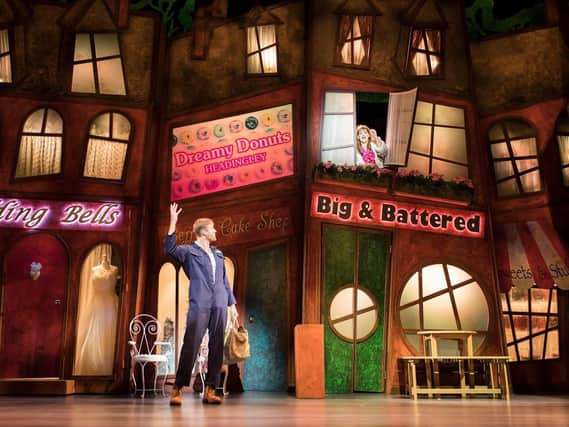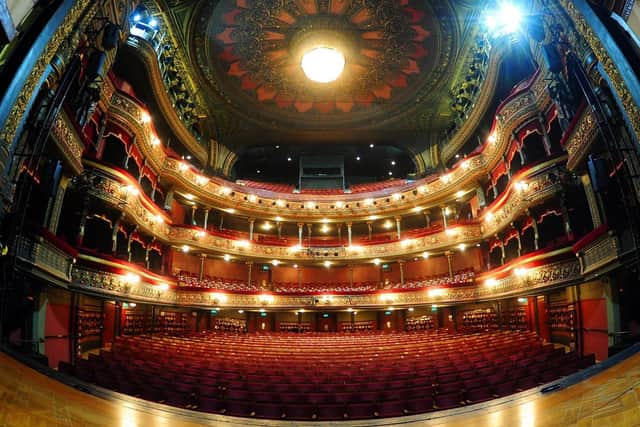Why Leeds Grand Theatre lives up to its opulent name


Leeds City Varieties and Leeds Grand Theatre. They’re run by the same organisation ultimately, so do I cover them in a single article? Sure, and with next week’s Culture I’ll cover the works of Shakespeare in a pamphlet.
While Leeds Grand is managed by the same city council-controlled company that runs the City Varieties and the beautiful Hyde Park Picture House, it would be a travesty to not give each venue its own article on my journey around Yorkshire. So this week it’s Leeds Grand Theatre.
Advertisement
Hide AdAdvertisement
Hide AdThe week before lockdown was announced, when the government was still issuing ‘very strong advice that public venues should not be visited’, but had not ordered venues to shut, I was at the Leeds Grand. I was there to see the premiere of Northern Ballet’s Geisha, a beautiful and moving piece of work from Kenneth Tindall.


Of all the theatres I’ve virtually visited in this series so far, it is the one that is perhaps most deserving of its name. It’s properly grand. There are those who think you should still dress up for a night at the theatre and I tend to go strongly against that view, but when I visit the Grand even I swap my trainers for shoes.
It is a Grand old building with an impressive history that dates back to 1878. In recent years the theatre has had new life breathed into it, not least with Transform, a massive transformation project in 2006 that, among other things, revealed beautiful original tiles that had been inexplicably plastered over. It also entirely, well, transformed the building.
Closing the doors, which happened the week after Geisha, was done with a heavy heart. “From street level you can’t possibly know what treasures await you beyond the front
doors.
Advertisement
Hide AdAdvertisement
Hide Ad"A conservation plan issued before the transformation plan noted that it was hard to find anything outside of London to compare with its ‘opulence, complexity and scale’,” says chief executive Chris Blythe.
“Closing our buildings has been a poignant reminder that without people, be that audience or staff, a building is just a building, no matter how grand. People breathe air into our theatres, they are the energy and life source, the real stars of our show.”
I understand why Blythe says that and the place obviously comes alive when there are people in it, but I’ve been in this building when it’s just been me and a couple of others and it is something incredibly special.
Surrounded by chicken shops, tattoo joints, bars and cigarette kiosks, it’s easy to forget just how special and just how sumptuous it is inside.
Advertisement
Hide AdAdvertisement
Hide AdMy camera roll is full of photographs of the inside of the auditorium, and I’m a pretty regular visitor. It’s just hard to resist the urge to capture the beauty inside, no matter how many times you’ve seen it.
It’s hard also to believe that we nearly lost the building. In 1968 the city council discussed plans to demolish the money-losing theatre and replace it was a 22-storey office block. The planning application was rejected, but the story serves as a timely reminder, as the building lies empty and facing an uncertain financial future once again that we cannot take these places for granted.
In recent years the theatre has had some staggering successes with world premieres of Gary Barlow and Tim Firth’s Calendar Girls The Musical, which opened at the venue in 2015 and returned in 2018, and Kay Mellor’s Fat Friends and Band of Gold in 2017 and 2019.
It shouldn’t be understated just how big a deal that is: the Leeds Grand is a receiving house, which means it doesn’t make its own productions, it stages what is already out there – except in these cases, it did.
Advertisement
Hide AdAdvertisement
Hide AdIan Sime, General Manager, says: “Our audiences deserve and expect to see the cream of the world’s performers, in the best productions of our time. Each production relies upon an equally important body of support staff including creative, technical and venue staff to create the magic.
“It is still a great thrill to work with such talented, passionate and committed individuals. Every performance and audience reaction is unique and meaningful and enriches our lives.
“Since opening, Leeds Grand Theatre has brought people into the city to be entertained – with generations of people coming through its doors for the top shows of the day, from Blue Beard the Grand in 1878 to panto in the 1960s, right up to today with tours of the very best West End musicals.”
Except today, it isn’t. It’s empty. Blythe says: “While we’re all working towards and looking forward to the day we can reopen our doors and welcome audiences back, we must face facts. Venues like ours will be the last to open.
Advertisement
Hide AdAdvertisement
Hide Ad“Our income generation will be limited potentially months after other parts of the economy start to grow. The whole industry will need to take stock as investors and producers of our wonderful shows have also taken a massive hit. But however daunting, I am certain we have a future.”
I’ve avoided using the cliché thus far, but it feels appropriate. At Leeds Grand the show must, surely, go on.
Editor’s note: first and foremost - and rarely have I written down these words with more sincerity - I hope this finds you well.
Almost certainly you are here because you value the quality and the integrity of the journalism produced by The Yorkshire Post’s journalists - almost all of which live alongside you in Yorkshire, spending the wages they earn with Yorkshire businesses - who last year took this title to the industry watchdog’s Most Trusted Newspaper in Britain accolade.
Advertisement
Hide AdAdvertisement
Hide AdAnd that is why I must make an urgent request of you: as advertising revenue declines, your support becomes evermore crucial to the maintenance of the journalistic standards expected of The Yorkshire Post. If you can, safely, please buy a paper or take up a subscription. We want to continue to make you proud of Yorkshire’s National Newspaper but we are going to need your help.
Postal subscription copies can be ordered by calling 0330 4030066 or by emailing [email protected]. Vouchers, to be exchanged at retail sales outlets - our newsagents need you, too - can be subscribed to by contacting subscriptions on 0330 1235950 or by visiting www.localsubsplus.co.uk where you should select The Yorkshire Post from the list of titles available.
If you want to help right now, download our tablet app from the App / Play Stores. Every contribution you make helps to provide this county with the best regional journalism in the country.
Sincerely. Thank you.
James Mitchinson
Editor